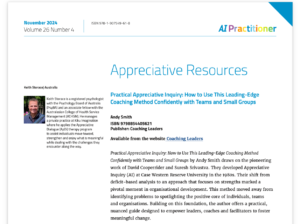Questions for the Design Stage

[ad_1]

The questions you ask, and the way you ask them, will have a big impact on your coaching client’s sense of agency and ability to come up with new ideas
In the Design stage of appreciative coaching, we are encouraging the client to come up with new ideas and choices for achieving their Dream vision of the future, or at least getting some way towards it. You could think of it as resembling the ‘Options’ part of the GROW model, although the client may be feeling more imaginative and creative as a result of the ‘Default Mode Network’ in their brains being activated by the preceding Discovery and Dream stages.
As stated previously, we’re looking for options, and as many of them as possible. The client is not required to commit to any of their choices at this stage. If the client comes up with an idea that we consider is not realistic, we’re not going to critique it. Selection for viability happens in the next stage, and a “bad” idea may spark other better ideas – if it is allowed to emerge.
Also, a reminder that we’re coaching in a non-directive way. Our role as the coach is to ask questions which direct the client towards possibilities that they may not have previously noticed, and to keep them on track during the process. The closer you can get to self-directed learning, the better.
So what questions might we ask, beyond the most basic “What could you do to get closer to the Dream?”
Example questions
Remember that we’re asking open rather than closed questions, because these are far more likely to elicit useful answers. If you hold the assumption that there are choices available, and that the client will be able to find them, your questions will automatically come out worded as open rather than closed.
Do I need to say that the following questions are suggestions for what you could ask, rather than a definitive list? Naturally, your choice of questions will be influenced by the context of your conversation so far.
- What could you do to make your goal happen?
- What could you do to improve things?
- What might someone else do in this situation?
- How have you overcome similar situations in the past?
- What conditions would have to be in place just before you achieve your desired outcome? And what would have to happen just before that? (and so on)
- Who do you know that has overcome a similar problem? How did they do it? How can you do that?
And a follow-up question that flows naturally from the assumption that there are more possibilities open to the client:
What if your client gets stuck?
Sometimes the client says that they don’t have any idea what they could do to get closer to their Dream. There are questions you can ask that will help them get started; which one you ask will depend on the reason for their hesitancy.
If they are reluctant to voice an idea unless they feel it has a realistic chance of succeeding, you can remind them that ‘all ideas are good ideas’ at this point. To get them started, you could ask “What’s the wackiest, most off-the-wall thing you could do?”
This question could also work to overcome inertia if they genuinely can’t think of any options to start with.
If they dismiss one of their ideas because it goes against some limiting belief they have, they might be worried about some awful consequence. Quite possibly, if they acquired some limiting belief in childhood that’s gone unexamined for decades, the imagined consequence might be unspecified – which makes it all the scarier.
The question “What would happen if you did?” can be useful to put the consequence under the spotlight, where it might turn out to be not as scary as they thought.
Sometimes the client doesn’t know where to start, because their Dream destination seems so far away and so different from where they are now that they can’t see even the beginnings of a route to get there. The important thing here is to get started, by thinking of ways to take one small step in roughly the right direction. So you could ask “What’s the smallest thing you could do?”
Alternatively, if you have already asked a scaling question in the Discovery stage to establish how they are assessing their current situation on a scale of 0 to 10 (where 0 is the worst it’s ever been, and 10 is where they’re going to be when they’ve overcome all their problems), you could use a further scaling question like this:
“You said that you’re at ‘n’ now – what would things be like if you were at ‘n+1’?”
Note that we are not asking yet “How will you get to ‘n+1’?” – we’re just asking what things would be like if things improved slightly and they were a little bit closer to their dream. Once the client has some image of what things could be like if they were just a little bit better, a part of their mind will automatically start looking for ways to get there.
image by ‘geralt’ at pixabay.com

If you would like to get started using Appreciative Inquiry with teams and small groups, take a look at our affordable Practical Appreciative Inquiry self-paced course – it also gives you $100 discount if you attend the live course later!
“I’m absolutely overwhelmed by the amount of great materials you’ve made available to me (and to the world!) All this has exceeded my expectations, many thanks and well done on this!” – Jason Harmon, communications trainer | team facilitator | management lecturer, UK
[ad_2]




